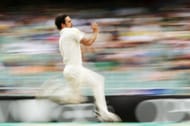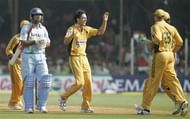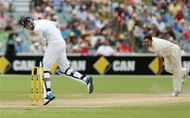As Mitchell Johnson walked off into the sunset after the draw in the second test between Australia and New Zealand, the game of cricket has become poorer without him. In the age where batsmen rule the roost with their immense bats on flat pitches, Johnson was the lone spark who was left in the ever-diminishing quota of good fast bowlers. It was perhaps fitting that he took the only two New Zealand wickets to fall in the second innings – both to bouncers. With that, he finished as Australia’s fifth highest wicket taker of all time, and certainly one of their most dangerous.After a poor debut in which he went for 1-157 against New Zealand, Johnson roared back with several impressive spells in both Tests and ODIs. Though he never reached great heights in the shorter format of the game, he was feared in the longer version. After Brett Lee, Glenn McGrath and Michael Kasprowicz announced their retirement from test cricket, it was left to be seen who would take on the mantle of Australia’s pace spearhead. It was then that Mitchell Johnson came roaring into the national side. Johnson, who wasn't even picked for the Cricket World Cup in 2007, would emerge as Australia’s best modern-day bowler.But pure pace alone never made a bowler threatening. Dale Steyn was menacing, but he slowly lost his pace over time. Morne Morkel was quicker than him, but he never looked particularly dangerous while he was bowling. But Mitchell Johnson rose above them all. He combined pace with aggression, menace with skill and accuracy with variation to go down as one of the best of all time.Let’s take a look at 5 reasons why Johnson was so feared by all:
#5 Speed Machine

Stories of how bowlers sacrificed pace to increase longevity are plenty in the modern game. Take Chaminda Vaas, Zaheer Khan or even Dale Steyn – they were all quick bowlers who shaved off a few miles per hour from their speed to ensure that they don’t lose the battle between the body and the game. Perhaps in the long run, it was the wise move. Stories of fast bowlers’ careers being ended by injuries are also rife – Shaun Tait, Shane Bond and Simon Jones come to mind. But there are bowlers still, who withstood the test of time and fatigue and came out on top, just as fast and menacing as they originally were. Mitchell Johnson was one such bowler.
Bounding in with a piercing glare, a vampirish face and a dragon tattoo, Mitchell Johnson was the cricketing equivalent of a sports car – lean, mean and a fighting machine. His left-arm roundarm was the first thing batsmen noticed, and it always gave them the appearance that the ball would move away from them. But Johnson learnt to swing it back in, which accounted for the best of batsmen thanks to his raw pace. When a good line and length didn’t bowl, Johnson stacked on the pace, dropping it shorter and shorter till the batsman danced around the pitch, trying not to make their faces a target.
Johnson also mastered the surprise delivery – only in his case, it was the yorker, not the bouncer. Once his trusty bouncer had been used enough, Johnson would sling it at the batsman’s toes, which would eventually get the poor man out LBW. Unlike regular bowlers who dropped pace with every over, Johnson kept cranking it up after every ball, as though wondering why the batsman was not yet running in fear. At the age of 33, when most fast bowlers would either enjoy a quiet cup of tea at home or turn into medium-fast bowlers, Johnson was bowling at 151 kmph to the South Africans en route to his 12 for 127 in Centurion last year.
Johnson’s terrifying visage only added to the aura of invincibility that seemed to emanate from him, and it definitely helped the cause. His 37 wickets in the 2013-14 Ashes series was his best, which included wicket tallies of 9, 8, 6, 8 and 6 in each test. Despite Australia putting in a team effort to win it 5-0, it will always be remembered for Mitchell Johnson running in with a handlebar moustache and ending up as a blur on the pitch.
#4 Not A One-Trick Pony

Sometimes, fast bowlers tend to repeat their tricks. Some bowlers stick to a single probing line outside off-stump, trying to entice the batsman into sticking their bat out. Some keep pitching the ball up and try to bring about expansive drives. Others perform only on certain surfaces, which are tailor-made for fast bowling but fail to make an impact on unresponsive wickets. Mitchell Johnson did not belong in any of those criteria – he was in a class of his own.
When pace didn’t help him, Johnson resorted to making it move off the pitch. In Vadodara, India found out the hard way. After an accurate bouncer took care of Yuvraj Singh, Johnson returned to take out MS Dhoni and Robin Uthappa to deliveries that straightened. In his second spell, he took one away from Irfan Pathan who could only nick it to the ‘keeper. Another rip-snorter saw Murali Kartik glove it to Gilchrist, and Johnson got his maiden five-for – in Indian conditions.
Johnson could have gotten his maiden five wicket haul in Kuala Lampur the year before, but rain dissolved his chances. In the space of 8 balls, he took 4 Indian wickets in the DLF Cup. Rahul Dravid poked at one which moved away and Irfan Pathan saw his off-stump being flattened. Tendulkar’s dismissal was a copy of Dravid’s and Yuvraj Singh fell to the short ball. From 20-0, India went to 35-5. And Johnson had arrived. His ability to bowl in batsman-friendly conditions was what made him stand out from the rest of the pack.
But that didn’t mean Johnson couldn’t bowl when the conditions suited him. In Hamilton in 2010, he took 6-73 against a blustered New Zealand side who were blown away by sheer pace. It went well with his 4-59 in the first innings, and Johnson got his second ever 10 wicket haul. It was almost a repeat performance of Brisbane two years ago, where Johnson took 5-39 against the same side. In his home ground Perth – dubbed the fastest track in the world – he took 8-61 against South Africa, who were the best side in the world in 2008. The fact that most of his wickets came with the old ball only bettered his reputation.
Johnson’s ability to vary his bowling arsenal was the main reason why he was feared in his prime. Some may argue that Johnson often varied it too much, which resulted in his lines going awry. But that takes nothing away from the fact that he could perform in any ground and in any condition.
#3 Destroyer of Men

Most fast bowlers would agree that it needs a special skill to truly unnerve the batsman. A bowler could have pace, accuracy and even the ability to appear threatening, but they need to be cut from a different kind of cloth to make the batsman cower in front of the stumps. Only the best of bowlers cause batsmen to take notice when they bound up to the crease. The delivery stride makes their eyes go wide, and the release causes their heart to leap into their mouth, wondering whether the ball would crash into their toes or their helmet. Mitchell Johnson had that effect on every batsman.
Even before Johnson ever played for Australia, stories of his exploits in the domestic circuits were being told and retold, about how he troubled several batsmen so much that the ‘keeper had to regularly stand a few extra metres behind to take the ball. In international cricket, it was the England team who became Johnson’s bunnies. Jonathan Trott, in particular, was so troubled that he left the tour halfway. Ian Bell and Alistair Cook received the short stuff in turn, and Bell, in particular, saw several deliveries graze his helmet’s visor.
Johnson loved bowling to left-handers in particular, which is evident from his statistics. He has dismissed world-class batsmen like Graeme Smith and Alistair Cook 9 times in his career, and has taken the wicket of left-handed batsmen 47 times in the last 5 years. Graeme Smith bore the brunt of Johnson’s one-two punch, which involved squaring the batsman with a bouncer and then pitching it up to induce a false stroke. Johnson also broke Graeme Smith’s arm and finger in 2010, after which the South African came out to bat to try and save the match. Ryan McLaren was another casualty, as he received a neck injury from Johnson and later got his arm broken as well. Not even the great Jacques Kallis was spared, as he took a bouncer to the jaw in 2009, forcing him to retire hurt.
Johnson’s ability to take apart the best of teams is what made him so good. It is never easy to master the art of fast bowling, but Johnson showed that he was up there with the best, thanks to his reputation preceding him.
#2 The Intimidation Game

It is said that fast bowlers needed to be mean and scary looking to truly strike fear in the hearts of batsmen. Bowlers often went out of their way to increase the feeling of trepidation among the batsmen and whipped up several traits to help them along the way. Different bowlers had their own unique style – the West Indian bowlers had the ‘glare’, Jeff Thompson had his roundarm action, Shoaib Akthar had raw pace and Merv Hughes had the handlebar moustache. Mitchell Johnson? He had them all.
His finest moment was definitely the 2013-1 Ashes, when he appeared with a fully grown handlebar moustache and proceeded to systematically dismantle England’s batting line-up. The amount of fear he created was so much that the batsmen trembled when he bounded up to the crease. They rarely committed on to the front foot, which showed that they were considering the possibility of a bouncer every ball. Much like his predecessors, Thompson, Lillee and even Brett Lee, Johnson tore through the opposition line-up with pure menace, giving the batsman a choice earful whenever he could.
Fast bowlers around the world approved, for Johnson’s terrifying visage only added to the pomp and grandeur of the game, which saw the English team being skittled out in every match. He didn’t stop there, for the moustache continued in the tour to South Africa as well. Perhaps it was his lucky charm, for he picked up 12 wickets in Centurion, where he breathed fire with every step and destroyed South Africa in their own backyard. He was so good that he picked up Graeme Smith and AB De Villiers in both innings of the match, a feat that few can boast of.
Mitchell Johnson may not have reached the late 150s while bowling, but his bowling was never short of menace. Batsmen were always in danger when Johnson was bowling, as most of them found out when they faced him up. Johnson may have blown hot and cold, but perhaps it was that very factor that made him so unpredictable - and so dangerous.
#1 Single Man Army

It is quite well known that fast bowlers hunt in pairs. Fast bowlers often made it their mission to seek a partner who could trouble batsmen as well as they could, and once they found one, they were unstoppable. Thompson-Lillee, Ambrose-Bishop, Wasim-Waqar and Garner-Marshall were the greatest of such pairs, and the way they terrorized batsmen was the stuff of legend. Even in modern times, the same is implemented in several sides.
Be it Steyn-Morkel for South Africa, Boult-Southee for New Zealand or even Starc-Pattinson for Australia, the very prospect of a tearaway tag-team is a bit daunting for batsmen. Then there was Mitchell Johnson, who took apart teams all by his lonesome threat.
Take Perth in 2008. South Africa had just landed in Australia and they were asked to bowl on the fastest track in the world. Despite their best efforts, Australia still managed a decent 375. In reply, Mitchell Johnson was set loose on a budding Protea team. Hashim Amla was not yet the batting behemoth he would become and AB De Villiers was just starting to show his range of shots. But they were still a force to be reckoned with – until they met Johnson. C
oming in with 10 overs to go for the new ball, he dismissed the well-set batsmen Jacques Kallis and De Villiers in consecutive overs. He then cleaned up the entire South African lower order in just 4 more overs, making sure they went from 234-3 to 256-9. The thing is – he only took one wicket with the second new ball. But his stellar performance was overshadowed by the South African second innings, where they chased down the world record score of 414 to win the match.
Johnson had several moments in his home ground of Perth, and perhaps his sweetest was in the Ashes of 2010 against the old enemy, England. After going 1-0 up in the series, England were sitting pretty to topple Australia yet again – this time in their own backyard. Australia put Johnson in, knowing that he would use the gentle breeze, called the ‘Fremantle Doctor’ to engineer some swing – and he did.
Johnson tore through England’s fabled middle order, taking out the old trio of Trott, Collingwood and Pietersen for scores of 4, 0 and 5. It spelled England’s doom as they were stunned into silence. He came back to prise out the last two wickets, and then took 3 more in the second innings, leaving him with match figures of 9/82. Though Australia lost the series, it was a major boost for Johnson’s career.
Perhaps all that was bettered in Adelaide in 2013, where he took 5 wickets in 18 balls to wrap up England’s first innings. He ripped apart England’s middle order with his bare hands, and was twice on a hat-trick. The effect of Johnson’s fiery spell was reflected in the scorecard, which saw all of England’s last 6 batsmen out for single figures. Johnson welcomed England with a barrage of bouncers, which saw batsmen like Alastair Cook, Jonathan Trott and Ian Bell ducking for cover from the deadly missiles that were targeted at them. He neatly wrapped the innings up with a yorker on Monty Panesar’s stump which also took out Channel Nine’s Stump Cam.
Johnson’s ability to change the course of the match all by himself was what made him so dangerous amongst his peers. Johnson redefined the theory that fast bowlers must hunt in pairs, and he showed that one man could indeed make a difference. With his retirement, the cricketing world has lost its last truly threatening bowler, and batsmen will now rest easy.
Follow IPL Auction 2025 Live Updates, News & Biddings at Sportskeeda. Get the fastest updates on Mega-Auction and cricket news
